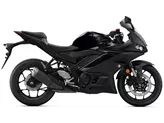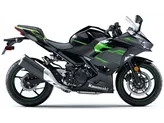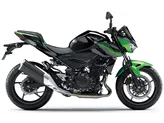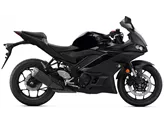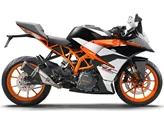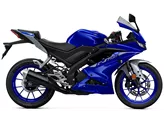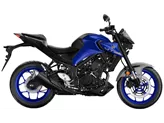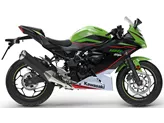Yamaha YZF-R3 2019 vs. Kawasaki Ninja 400 2018

Yamaha YZF-R3 2019

Kawasaki Ninja 400 2018
Visão geral - Yamaha YZF-R3 2019 vs Kawasaki Ninja 400 2018
In terms of technical specifications, the Yamaha YZF-R3 2019 has a smaller engine displacement of 321cc compared to the Kawasaki Ninja 400 2018 which has a displacement of 399cc. However, the Ninja 400 has a slightly higher horsepower of 45 compared to the YZF-R3's 42. The Ninja 400 also has a higher torque of 38 Nm compared to the YZF-R3's 29.6 Nm. Both bikes have a 2-cylinder engine with 4 valves per cylinder.
In terms of suspension, the YZF-R3 2019 has a telescopic fork front suspension with a diameter of 37mm, while the Ninja 400 2018 also has a telescopic fork front suspension but with a larger diameter of 41mm. Both bikes have a swingarm rear suspension.
In terms of chassis, the YZF-R3 2019 has a double tube frame with a rake of 25 degrees and a trail of 95mm. On the other hand, the Ninja 400 2018 has a tubular frame with a rake of 63 degrees and a trail of 93mm.

Yamaha YZF-R3 2019
Both bikes have a single disc front brake, with the YZF-R3 having a diameter of 298mm and the Ninja 400 having a larger diameter of 310mm. Both bikes also come with ABS as a standard feature.
In terms of dimensions and weights, both bikes have the same front tire width of 110mm and diameter of 17 inches. However, the Ninja 400 has a wider rear tire width of 150mm compared to the YZF-R3's 140mm. Both bikes have the same rear tire diameter of 17 inches. The YZF-R3 has a slightly longer wheelbase of 1380mm compared to the Ninja 400's 1370mm. The seat height of the YZF-R3 is 780mm while the Ninja 400 has a slightly higher seat height of 785mm. Both bikes have a curb weight of around 168-169kg with ABS. Both bikes also have a fuel tank capacity of 14 liters.

Kawasaki Ninja 400 2018
In terms of strengths, the YZF-R3 2019 is known for its high-revving engine, sufficient power for daily use and compact race tracks, and its stable handling. It is also considered a good base for track conversions and is suitable for long distances. On the other hand, the Ninja 400 2018 is praised for its chassis that is suitable for sporty use, lightweight and effortless handling, smooth engine response, relaxed seating position that increases confidence, and LED headlights.
In terms of weaknesses, the YZF-R3 2019 is criticized for its weak throttle response at low revs and insufficient feedback on the brake lever. Some riders may also find the knee angle too sharp. The Ninja 400 2018, on the other hand, has non-adjustable brake and clutch levers and high wind noise with the stock windshield for riders over 180cm tall.
Overall, both the Yamaha YZF-R3 2019 and the Kawasaki Ninja 400 2018 have their own strengths and weaknesses. The YZF-R3 is more suited for high-revving performance and long-distance riding, while the Ninja 400 offers a sportier chassis and a more relaxed seating position. Ultimately, the choice between the two would depend on the rider's preferences and intended use of the motorcycle.
Especificações técnicas Yamaha YZF-R3 2019 em comparação com Kawasaki Ninja 400 2018
Prós e contras em comparação
Prós e contras em comparação
Yamaha YZF-R3 2019

Com a nova YZF-R3, a Yamaha pegou na base muito boa da primeira geração e desenvolveu-a com sucesso. Agora parece não apenas visualmente mais madura, mas também visivelmente mais competente em altas velocidades. Quando se conduz a R3 no limite, sente-se rapidamente porque é que a Yamaha criou a sua própria Taça, já que até o modelo de série proporciona uma sensação de segurança a alta velocidade. No entanto, há espaço para melhorias, especialmente no uso diário, quando a resposta áspera em baixas rotações e o fraco feedback da alavanca do travão levam a alguns momentos de frustração durante a condução.
Kawasaki Ninja 400 2018

Em resumo, a Ninja 400 pode ser descrita como a entrada perfeita no mundo das superdesportivas. Não é possível obter mais potência com a A2, o aspeto sugere muito mais potência, o veículo é divertido de conduzir, é indulgente em todos os aspectos e ainda permite um estilo de condução verdadeiramente desportivo. Aqueles que tinham preocupações legítimas sobre a falta de potência nas várias máquinas de 250 cúbicos agora não têm mais desculpas. Ninja 400, é bom ter-te connosco!
Comparação de preços Preço médio de mercado Yamaha YZF-R3 vs Kawasaki Ninja 400
There are a few key differences between a Yamaha YZF-R3 2019 and a Kawasaki Ninja 400 2018. In terms of price, the actual average price of a Kawasaki Ninja 400 2018 is about 9% higher. Compared to Kawasaki Ninja 400 2018 there are less Yamaha YZF-R3 2019 bikes available on the 1000PS.de Marketplace, specifically 4 compared to 10. It takes less time to sell a Yamaha YZF-R3 with 99 days compared to 105 days for a Kawasaki Ninja 400. Since model year 2015 1000PS.de editors have written 11 reviews for the Yamaha YZF-R3 and 9 reviews for the Kawasaki Ninja 400 since model year 2018. The first review for the Yamaha YZF-R3 was published on 17/10/2014 and now has more than 53.600 views. This compares to more than 44.300 views for the first review on Kawasaki Ninja 400 published on 22/11/2017.


